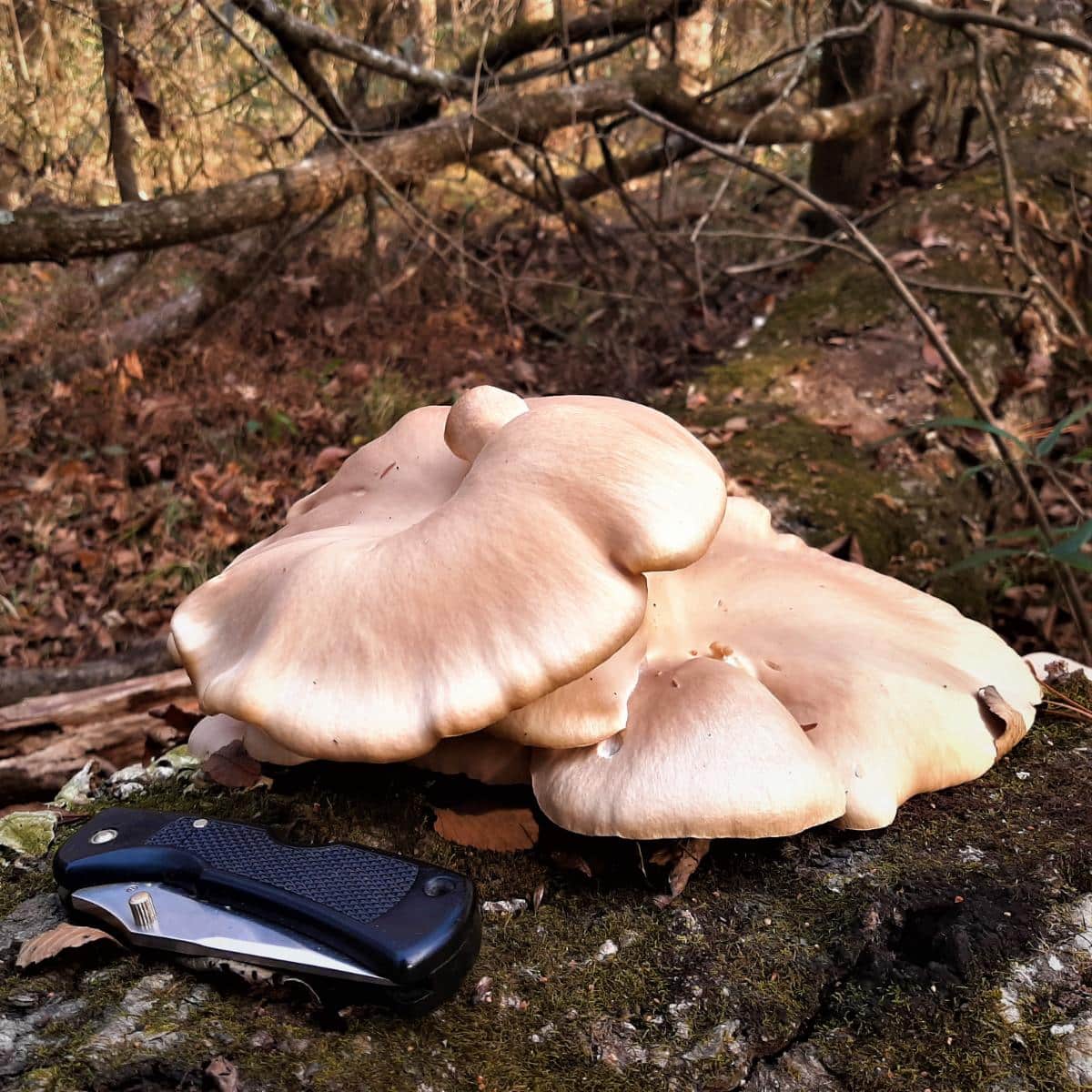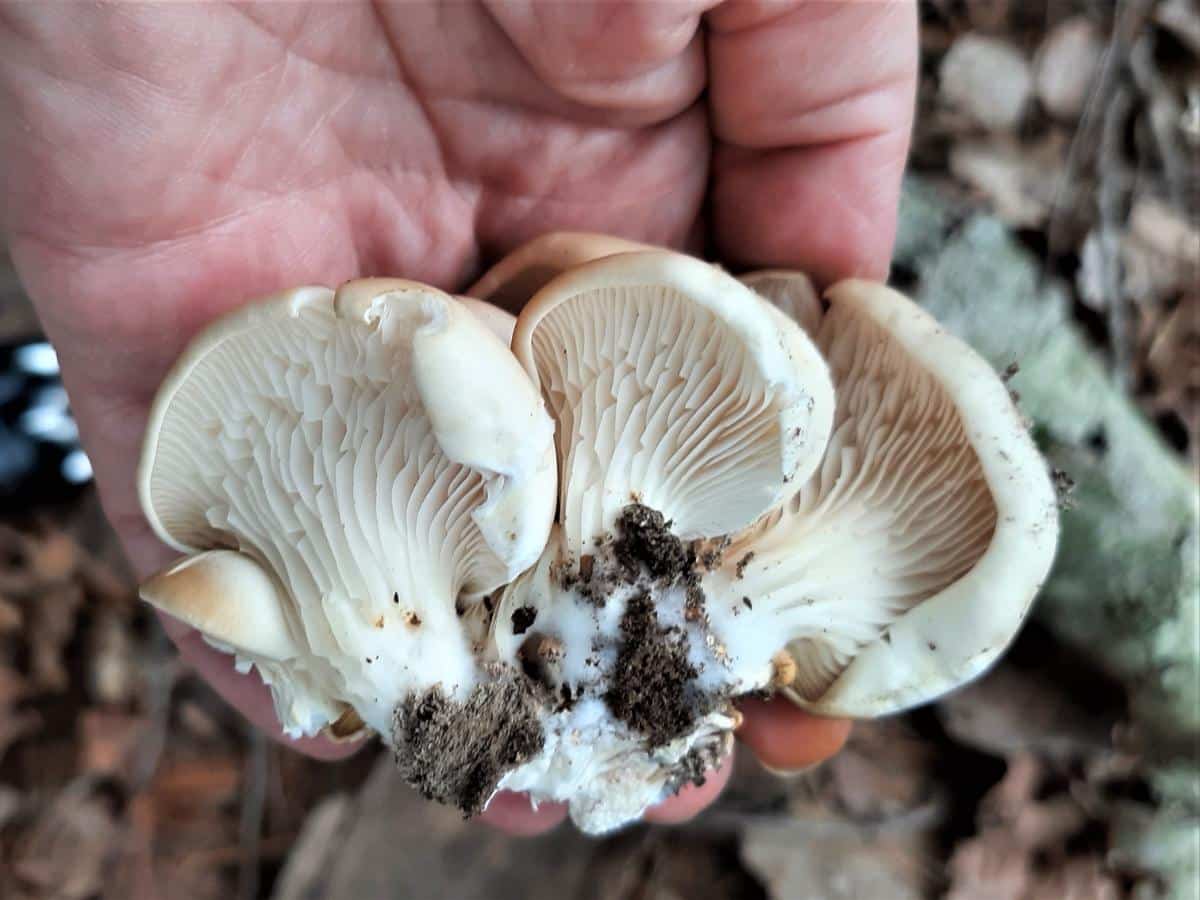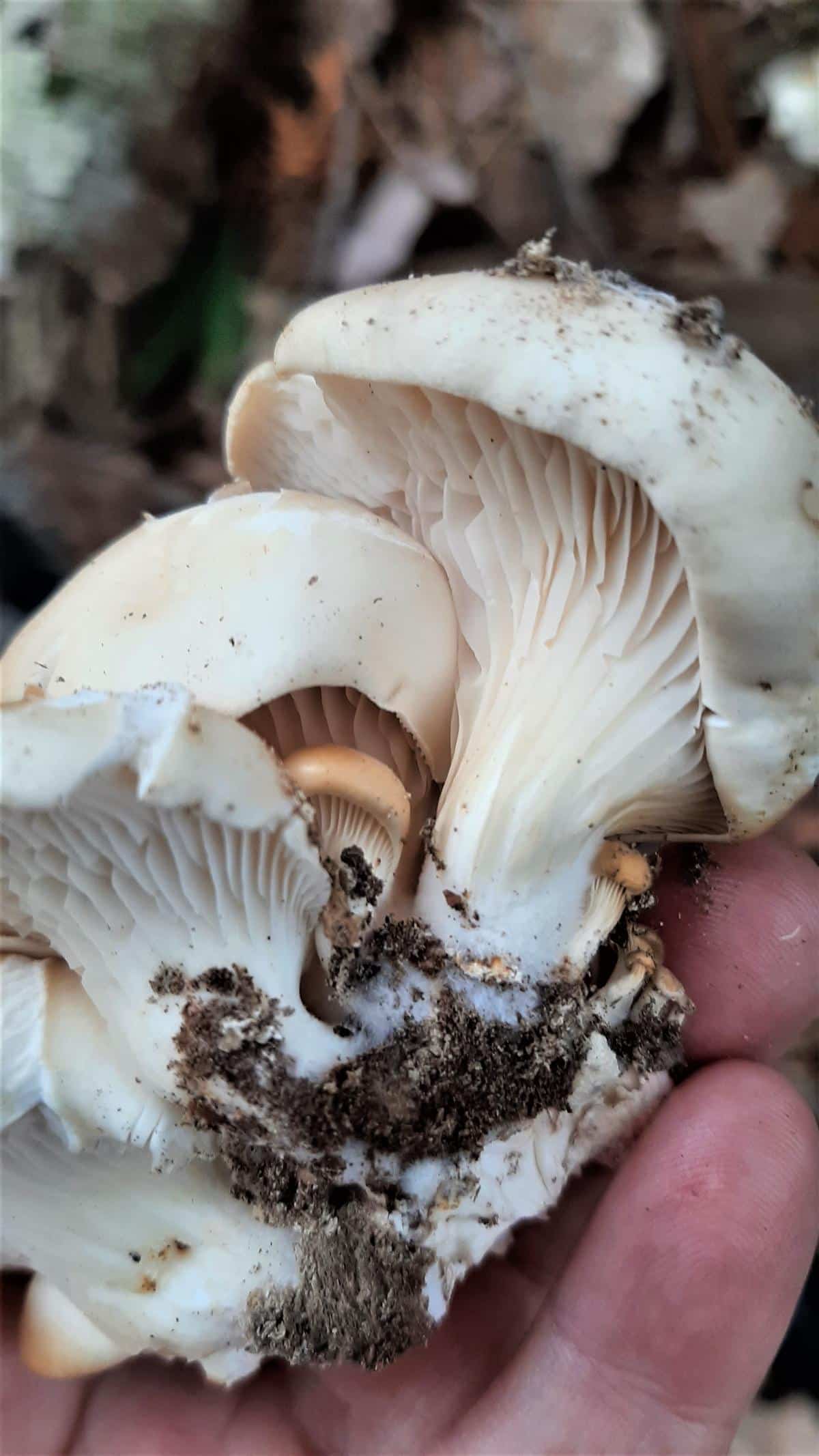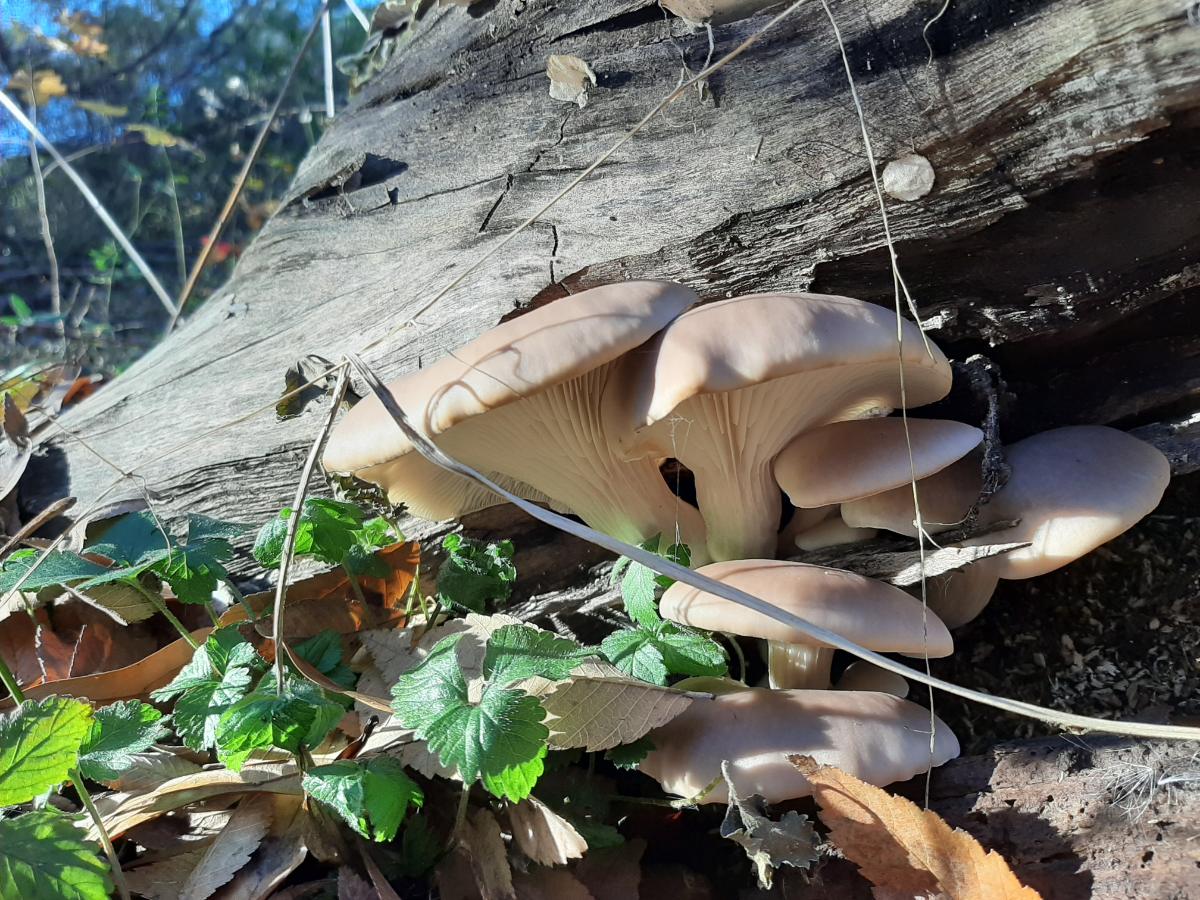Lately, I’ve received a number of emails asking me about oyster mushroom identification. The most recent one came in early December from a reader named Tracey. She writes:
Wondering if you could help me. I took photos of mushrooms growing on tree stumps that I had that I could not split and set upright to dry out. This is in Western Pennsylvania a few days ago. Our winter has been very mild so far (40-50 degrees) and damp. Is this the oyster mushroom? And are there mushrooms that could look like this and be poisonous?

Great questions, Tracey! Let’s take a closer look at oyster mushroom identification.
Please remember to never eat any mushroom if you’re not absolutely sure what it is. The Internet is a great resource, but if you’re a beginner you should show your find to a real live expert to be safe. Nothing beats an in-person identification!
Looking for recipes? Check out our in-depth guide: How to Clean and Cook Oyster Mushrooms: Complete Oyster Mushroom Preparation Guide.
Jump to:
All About Oyster Mushrooms
- They’re easily cultivated and one of the top commercially grown mushrooms.
- You can grow oyster mushrooms at home! Check out our guide to mushroom grow kits which includes recommendations for growing oysters.
- Oysters are FAR more than just a simple edible mushroom. They possess incredible abilities to absorb and clean up pollution, mitigate oil spills, and are being used to make mushroom leather. If there is one mushroom that will change the world, it is the oyster! Oh, and they’re medicinal!
Oyster Mushroom Identification
Pleurotus ostreatus, is a common edible known for its oyster-shaped cap. One of the first things you should look for when trying to identify this mushroom is the presence of decurrent gills.
Decurrent means that the gills are attached to and run directly down the stem. Take a look at the close-up. Can you see how they run into and down the stem?


Other identification features:
Cap
- Oyster or fan-shaped, usually 2-10 inches across (5-25 cm).
- Often grow in a shelf-like formation with overlapping clusters.
- Smooth, with no warts or scales.
- Usually white to light brown with firm, white flesh.
- The gills are white and are attached to and running down the cap and stem (decurrent).



Stem
- They may not have a stem. If they do it will often be stubby and off-center if the mushroom is growing on the side of a log. If it’s growing on the top you will see a more well-developed stem.
- No ring around the stem, and no sack around the base.
- The flesh is white.


Spore print
White to lilac-gray. It’s best to make the spore print on a dark background.
Habitat
- These mushrooms are saprotrophic, meaning they feed on dead material, in this case wood. Thus you’ll find them growing on logs or sick or dying trees.
- Most often found on deciduous hardwoods (trees that lose their leaves). Beech and aspen trees are common. Sometimes found on conifers as well.



Smell
Oyster mushrooms have a mild anise odor, meaning they smell a little sweet like licorice.
Time of year
Summer and fall, or winter as well in warmer areas.

The Oyster Bugs
It is so common to find these little black beetles in oyster mushrooms that it can also be used as an identification point. If I ever question whether it’s an oyster, than see the beetles, then I’m sure. They’re not always there but probably at least 80% of the time, there are at least a few.
On older oyster specimens (older, as in a 3-5 days old), they’re extremely common and likely. The beetles aren’t problematic unless they’ve chewed up tons of the mushroom. Then the mushroom isn’t very good to eat anymore.


These beetles are actually one of potentially 30 or so different beetle families with around 136 different species. Many of them are obligatory mycobionts. This means they need fungi for food.
They are not limited to P. ostreatus, but they do like the oysters a lot. Some of these black beetles may live their entire lives in the mushroom. Other bug species are predatory on mycobionts, so that they too are dependent on the mushrooms.

Oyster Mushroom Look-Alikes
This page tells you how to identify Pleurotus ostreatus, the common oyster mushroom. However, there are other mushrooms in the Pleurotus genus that are also referred to as oysters. A few examples are:
- Pleurotus citrinopileatus – The Golden Oyster
- Pleurotus populinus – Aspen Oyster
- Pleurotus pulmonarius – Phoenix Oyster
- Pleurotus dryinus – Veiled Oyster
- Panellus serotinus – Late Fall Oyster
- Hypsizygus ulmarius – Elm Oyster
These species are all edible, so if you mistake a phoenix oyster for a true oyster, you will not be poisoned.
To tell an elm oyster from a true oyster, take a look at the gills. The gills of a true oyster run down the stem, the gills of an elm oyster does not. The elm oyster is edible, although some say not as tasty.
So are there any poisonous look-alikes? The poisonous Omphalotus nidiformis is sometimes mistaken for an oyster. It grows in Japan and Australia so become familiar with it if you live in those countries.
Some folks are cautious with angel wings, due to reports of them being deadly Read up on the angel wings controversy to learn more. Angel wings only grow on conifer, so that is the best way to rule them out when foraging.
The same rules apply here as with any other species. Become familiar with them through reading and pictures, try to find them in the wild, and check your finds with someone who knows in real life. Taking a spore print and checking for gill attachment can be a big help.
Cooking With Oyster Mushrooms
Oyster mushrooms are incredibly versatile. They taste great pan-fried with butter and garlic and also deep-fried with a crumb coating. Because oysters are one of the easiest mushrooms to grow, restaurants have easy access to them for trying new recipes. This means there is literally a glut of recipes out there for these delicious mushrooms.
Looking for recipe ideas? Check out our in-depth guide: How to Clean and Cook Oyster Mushrooms: Complete Oyster Mushroom Preparation Guide.

The oyster mushroom doesn’t have a lot of flavor, but that’s actually good. It is sort of like chicken — it isn’t super flavorful but it does have a nice mild umami taste. When you prepare it with something else, though, it really shines.
These mushrooms are dense, don’t lose their texture, hold up in all types of cooking, and can be cooked almost any way possible. Here’s some great recipes to get you started:
- Simple Sautéed Oyster mushrooms
- Fried Oyster Mushrooms
- Oyster Mushroom Noodle Stir-Fry
- Oyster Mushroom Chowder
- Oyster Mushroom Po’ Boy
- Pickled Oyster Mushrooms
- Baked Oyster Mushroom Croutons
- Crispy Air-Fried Oyster Mushrooms
- Korean Barbeque Crispy Oyster Mushrooms
- Oyster Mushroom and Spring Onion Frittata









Greg says
Best habit for morels
Jenny says
It all depends on where you live — check out this guide to all the species and their preferred habitats https://www.mushroom-appreciation.com/morel-species.html
Bill says
Thank you Jenny This is a very informable Site I’ve been growing mushrooms for about 3 years now I live in Western Carolina And seem to have a large variety of mushrooms And a lot of mushrooms I find I have a hard time identifying or finding any information about
Jenny says
I’m happy to be helpful! 🙂 There are thousands of mushroom out there, and identifying them can be tricky. Just take your time, be patient, and learn as you go — that’s how most people become successful
Terry says
What about Angel Wings? Pleurocybella porrigens. These look very much like Oyster mushrooms but may be toxic. How can you tell them apart?
Jenny says
Great point, I should link to the article I wrote about Angel wings and include the controversy in this article. There are no reported toxic events from eating angel wings in the US and folks have been eating them for centuries, so… are they really problematic? https://www.mushroom-appreciation.com/angel-wings-identification.html
Allen Willoughby says
Just trying to confirm that these are oyster mushrooms…please.
Now just tell me how to upload a couple of pictures….thanks!
Jenny says
This is not a place to upload pictures. Please go to our facebook group, make sure to read the announcement how about to submit images, and upload it there Mushroom Lovers FB Group
Kimberley says
Great info. Super helpful and confirmed what we already expected. These are oyster mushrooms in the woods.
Jenny says
Thanks! And hope you enjoyed those oyster mushrooms 🙂
Curiouser says
I just found the most amazing Mushroom under my flower bed that does have rotting wood in the bottom, since it’s coming from out of the bottom of the bed, it may be fungi, it looks like it has fills but the shapes are amazing and look just like giant oysters in the ocean. How do I send a pic?
Jenny says
You can submit images to our facebook group. Make sure to read the pinned/featured post to make sure you include all the necessary info and images.
Greg says
Thanks for making this site, it has helped me to ID some oyster mushies I found today here on west coast, BC. I have eaten them a few years ago and they are yummy.
Jenny says
Awesome! Glad the site helped and glad you found some tasty oysters!
Sandy Hendrickson says
I love this site! So glad I found it, and you! My husband has Chronic Kidney disease. Not sure if there’s a correlation to mushrooms, but some species , like Chicken of the Woods, make him very sick. So I’ve given up foraging mushrooms. I have a stump that produces Oyster mushrooms, but I think the stump has lost all nutrients to support more mushrooms. But he can eat oyster mushrooms. Can you suggest a good outlet for buying the blocks or plugs? Thank you so much!
Jenny says
Here’s my guide to the best grow kits and suppliers 🙂 https://www.mushroom-appreciation.com/mushroom-growing-kits.html
Judy Mitchell says
I have an identification question. I am quite novice in identifying fungi, but have safely eaten boletes, lobster, chanterelles and maybe a few others.
I have found a stump with several what I thought would be oyster mushrooms, but there are no gills, and there are many irregular shapes. What could they be?
They are growing on a deciduous tree stump in a pine forest, with several lobster mushrooms growing nearby.
I would love to provide a few photos, but don’t seem to see a method to do that.
Jenny says
If there are no gills, definitely not an oyster mushroom. We have a facebook group for ID questions — make sure to read the pinned/featured post to include all the relevant information. Would love to see what you’ve found
Terry says
I stumbled on this site while searching for information on a group of reddish/brownish oyster type mushrooms I found in the woods on a deciduous tree today, October 18, 2024. The past couple weeks have been wonderful for oysters on box elder trees here in central New York but this is the first time that I can recall seeing red ones. They’re small, so young, and came on the heels of two frosty nights so I’m quite certain they fit the description of late fall “oysters”. I’m going back to pick some and add them to the stew I have in the crockpot. Thanks for your help!
Jenny says
Reddish oysters, hmmm. Late Fall ones are usually greenish, so I’m not sure what you found. Can you submit photos to our facebook group (read the pinned/featured post to make sure to include all necessary info) https://www.facebook.com/groups/340690111324762
Brigid O'Dowd says
Great website, I learned a lot already, my initial interest was in boletes. I think we have a lot of them in the California coastal redwoods here, but maybe not the best eating ones, although I am not a forager, just interested in the remarkable variety and beauty of the wild mushroom. Definitely we have a lot of oyster mushrooms, which I am lucky to get any kind of photo of, because there are savvy foragers here who do pick them quickly. Thanks again for great website, just spending about 30 minutes on it, my mushroom I.Q. rose considerably!
Jenny says
This made my day :). Glad you find the site useful. Boletes are everywhere and I bet there are some good edible ones near you! https://www.mushroom-appreciation.com/all-about-boletes.html
Robin C says
I have a tree with LOADS of oyster mushrooms on it. Can I freeze them?
Jenny says
They are best frozen after being cooked. Freezing raw results in a weird texture. I usually prepare them in a soup or stew and freeze that.
Debbie of house Giles says
Hi, thank you for the info.
I’m wondering why I see maggots in oysters? As you mentioned beetles, do you think that they could be the larvae of the beetles? Thanks
Jenny says
Yes, that would be the beetle larvae. Usually by that point, the mushrooms aren’t worth eating – when I see this, the oysters are usually really mushy and falling apart.
Brenda Lee Hogue-trotter says
Thanks for all the great things about oysters. I found some but wasn’t sure
And got worried so I threw them away,
One reason was I was looking on our ranch. After finding them we never found another one. We looked all day , and nothing! It’s still warm here in Oklahoma so I thought maybe they were angle wings. So I’ve told my self ” when in doubt throw them out” so I did .
Now I’ve read this, I know they where oysters. But oh well. I’ll just have to find more.
Jenny says
They usually return to the same spot yearly, so check that location next year around the same time!
Winni Constance says
I completely agree with your points. The research behind this is impressive. Your writing style kept me engaged.